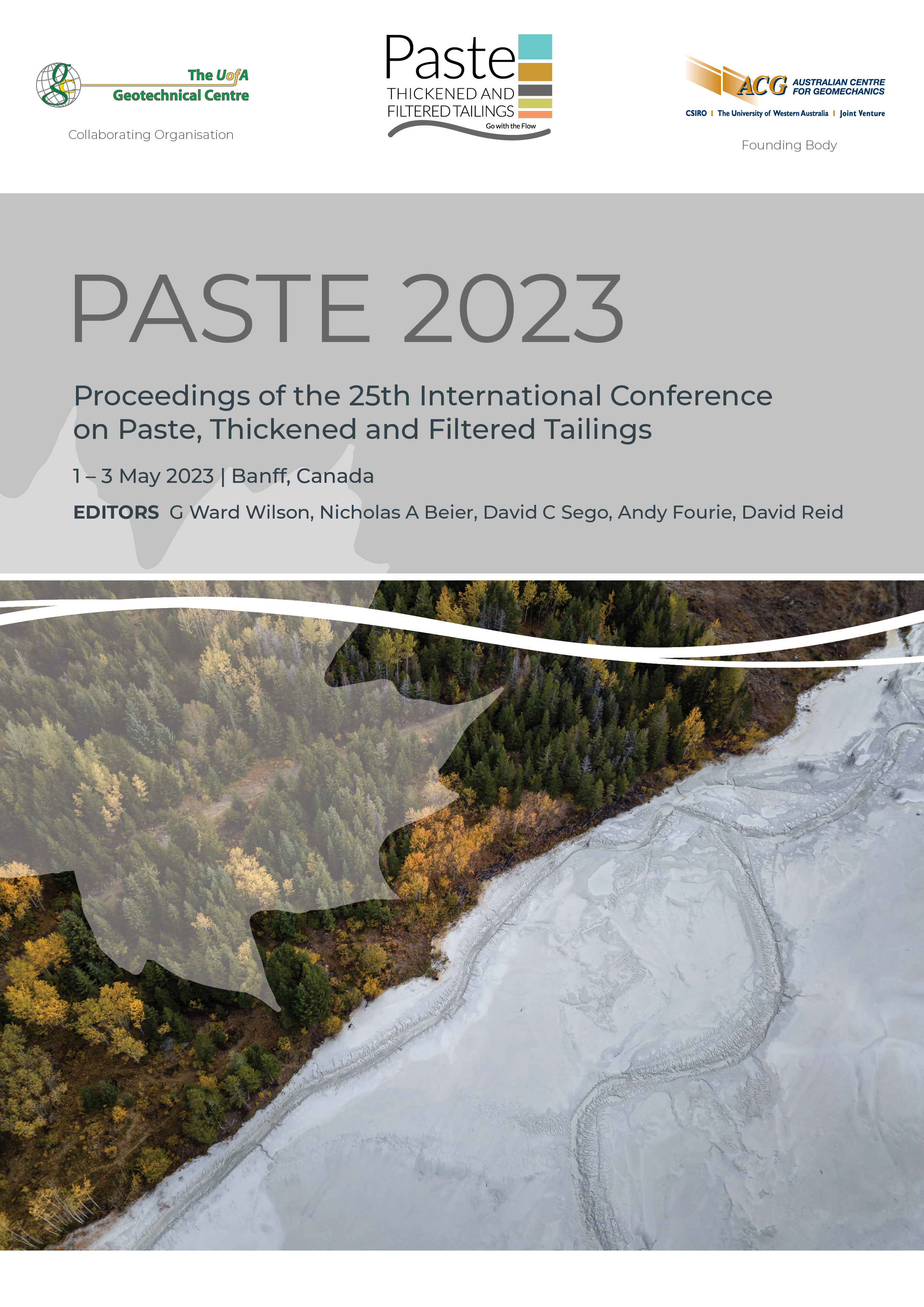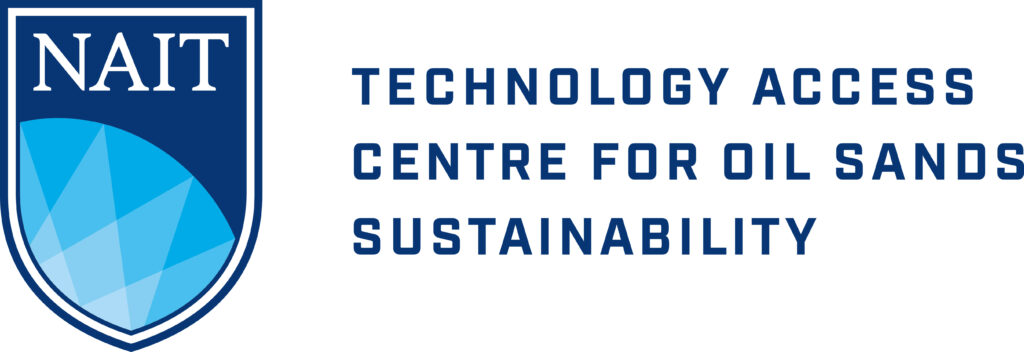Assessment of static liquefaction susceptibility of early age cemented paste backfills

|
Authors: Belem, T; Mbonimpa, M; Oke, J; Gélinas, LP |
DOI https://doi.org/10.36487/ACG_repo/2355_11
Cite As:
Belem, T, Mbonimpa, M, Oke, J & Gélinas, LP 2023, 'Assessment of static liquefaction susceptibility of early age cemented paste backfills', in GW Wilson, NA Beier, DC Sego, AB Fourie & D Reid (eds), Paste 2023: Proceedings of the 25th International Conference on Paste, Thickened and Filtered Tailings, University of Alberta, Edmonton, and Australian Centre for Geomechanics, Perth, pp. 154-169, https://doi.org/10.36487/ACG_repo/2355_11
Abstract:
The use of cemented paste backfills (CPB) for stope filling as a tailings management method becomes almost indispensable for flexible, selective and safe underground mining operations. For CPB to play the role of secondary ground support, it must develop a certain uniaxial compressive strength (UCS). The UCS value is almost linearly proportional to the binder content used. However, the cost of the binder represents 8 to 16% of the operating costs of mining with cemented backfill. That is the reason why mining companies seek to reduce the binder cost by reducing the amount of binder in the CPB mixtures. Unfortunately, a reduction in the binder content could cause a significant decrease in CPB strength, particularly at early ages. Such a CPB strength reduction, under undrained conditions, may cause liquefaction-induced failures at early ages due to seismic shaking or static loading. Static liquefaction can occur if the CPB show contractive behaviour during undrained loading and if there is a triggering mechanism present. The triggering mechanism can be due to a rapid rate of CPB raising (overloading), changes in porewater pressure or reduction in lateral confinement. The objective of this study is to experimentally assess the static liquefaction susceptibility of CPB containing low percentages of HS Portland cement (1.5, 1.75 and 2 wt%) at early ages (3 and 7 days). For each cement percentage and both curing times, isotropically consolidated undrained (CIU) triaxial compression tests were performed. Preliminary results are provided and the conditions for static liquefaction triggering are either null effective minor stress or when the pore pressure ratio (ru) reaches or is close to unity (ru = u/’3 = 1). The results showed that only the CPB studied using 1.5 wt% cement reached the condition of initial static liquefaction temporarily (axial strain in the range 0.5–3.5%) before resisting against liquefaction development (dilative behaviour).
Keywords: static liquefaction, cemented paste backfill (CPB), unconfined compressive strength (UCS), consolidated undrained triaxial, contractive behaviour
References:
Aref, K 1988, A Study of the Geotechnical Characteristics and Liquefaction Potential of Paste Backfill, PhD thesis, McGill University, Montreal, 620 p.
ASTM International 2020, Standard Test Method for Slump of Hydraulic-Cement Concrete (ASTM C143/C143M-20), ASTM International, West Conshohoken.
ASTM International 2020, Standard Test Method for Consolidated Undrained Triaxial Compression Test for Cohesive Soils (ASTM D4767-11), ASTM International, West Conshohoken.
ASTM International 2021, Standard Test Method for Compressive Strength of Cylindrical Concrete Specimens (ASTM C39/C39M-21), ASTM International, West Conshohoken.
Aubertin, M, Bussière, B, Bernier, L, Chapuis, R, Julien, M, Belem, T & Li, L 2002, ‘La gestion des rejets miniers dans un contexte de développement durable et de protection de l’environnement’, Comptes-rendus du Congrès Annuel de la Société Canadienne de Génie Civil.
Belem, T, Effenguet, H & Mbonimpa M 2013, ‘Estimation of required minimum binder content by assessing the liquefaction potential of early age cemented mine backfill’, Proceedings of the 66th Canadian Geotechnical Conference, The Canadian Geotechnical Society, Vancouver.
Belem, T & Benzaazoua, M 2008, ‘Underground mine paste backfill technology: applications and design methods,’ Geotechnical and Geological Engineering, vol. 26, no. 2, pp. 147–174.
Belem, T & Mbonimpa, M 2016, ‘Minimum strength required for resisting to cyclic softening/failure of cemented paste backfill at early age’, Proceedings of the 3rd International Symposium on Mine Safety Science and Engineering, McGill University, Montreal.
Belem, T, Benzaazoua, M & Bussière, B 2000, ‘Mechanical behaviour of cemented paste backfill’, Proceedings of the 53rd Annual Conference of the Canadian Geotechnical Society.
Benzaazoua, M, Belem, T & Bussière, B 2002, ‘Chemical aspect of sulfurous paste backfill mixtures’, Cement and Concrete, vol. 32, no. 7, pp. 1133–1144.
Benzaazoua, M, Fall, M & Belem, T 2004, ‘A contribution to understanding the hardening process of cemented pastefill’, Minerals Engineering, vol. 17, no. 2, pp. 141–152.
Davies, M, McRoberts, E, & Martin, T 2002, ‘Static liquefaction of tailings – fundamentals and case histories’, Proceedings of Tailings Dams 2002.
Fourie, AB, Blight, GE & Papageorgiou, G 2001, ‘Static liquefaction as a possible explanation for the Merriespruit tailings dam failure’, Canadian Journal Geotechnical Journal, vol, 38, pp. 707–719.
Grice, T 1998, ‘Underground mining with backfill’, Proceedings of the 2nd Annual Summit on Mine Tailings Disposal Systems.
Kramer, SL & Seed, HB 1988, ‘Initiation of soil liquefaction under static loading conditions’, ASCE Journal of Geotechnical Engineering, vol. 114, no. 4, pp. 412–430.
le Roux, K, Bawden, W & Grabinsky, M 2004, ‘Liquefaction analysis of early age cemented paste backfill’, Proceedings of The Eighth International Symposia on Mining with Backfill, pp. 233–241.
Potvin, Y, Thomas, E & Fourie, AB (eds) 2004, Handbook on Mine Fill, Australian Centre for Geomechanics, Perth.
Poulos, SJ, Castro, G & France, JW 1985, ‘Liquefaction evaluation procedure’, ASCE Journal or the Geotechnical Engineering, vol. III, no. GT6, pp. 772–792.
Sladen, JA, D’Hollander, RD & Krahn, J 1985, ‘The liquefaction of sands, a collapse surface approach’, Canadian Geotechnical Journal, vol. 22, no. 4, pp. 564–578.
Thompson, BD, Bawden, WF & Grabinsky, MW 2012, ‘In situ measurements of cemented paste backfill at the Cayeli Mine’, Canadian Geotechnical Journal, vol. 49, no. 7, pp. 755–772.
© Copyright 2024, Australian Centre for Geomechanics (ACG), The University of Western Australia. All rights reserved.
View copyright/legal information
Please direct any queries or error reports to repository-acg@uwa.edu.au
View copyright/legal information
Please direct any queries or error reports to repository-acg@uwa.edu.au



